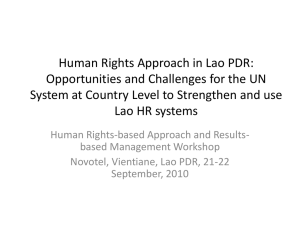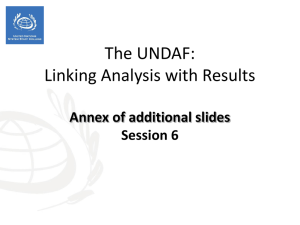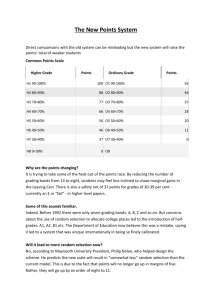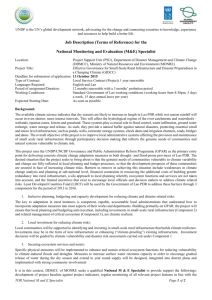Resolution of the Lao PDR Government on National Population and
advertisement
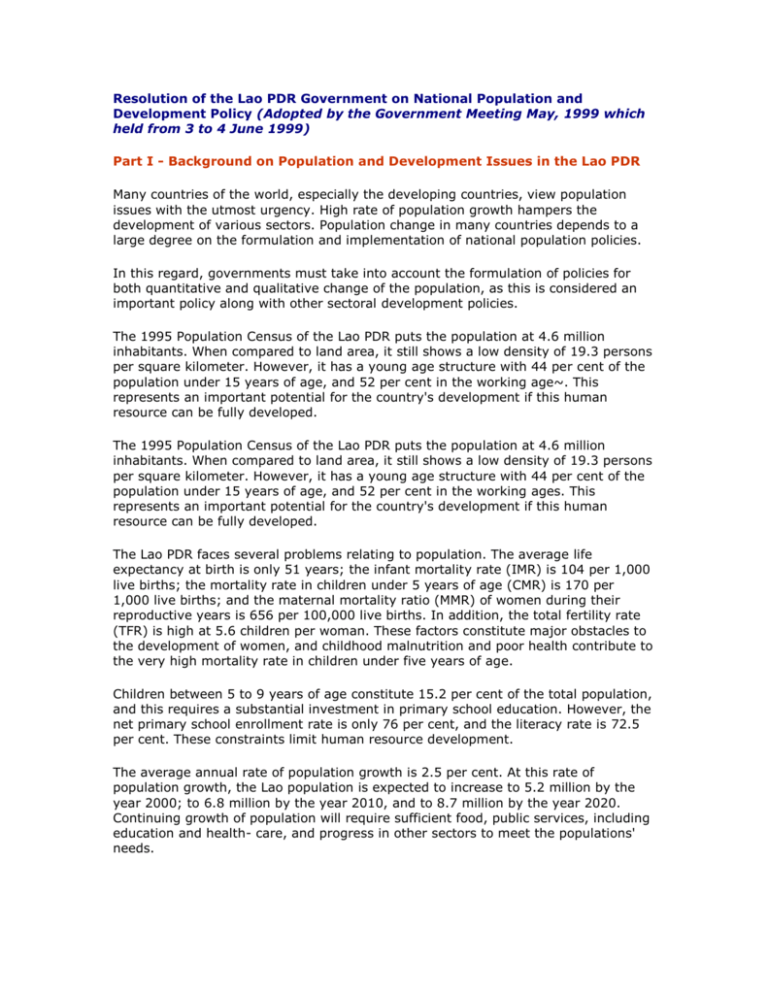
Resolution of the Lao PDR Government on National Population and Development Policy (Adopted by the Government Meeting May, 1999 which held from 3 to 4 June 1999) Part I - Background on Population and Development Issues in the Lao PDR Many countries of the world, especially the developing countries, view population issues with the utmost urgency. High rate of population growth hampers the development of various sectors. Population change in many countries depends to a large degree on the formulation and implementation of national population policies. In this regard, governments must take into account the formulation of policies for both quantitative and qualitative change of the population, as this is considered an important policy along with other sectoral development policies. The 1995 Population Census of the Lao PDR puts the population at 4.6 million inhabitants. When compared to land area, it still shows a low density of 19.3 persons per square kilometer. However, it has a young age structure with 44 per cent of the population under 15 years of age, and 52 per cent in the working age~. This represents an important potential for the country's development if this human resource can be fully developed. The 1995 Population Census of the Lao PDR puts the population at 4.6 million inhabitants. When compared to land area, it still shows a low density of 19.3 persons per square kilometer. However, it has a young age structure with 44 per cent of the population under 15 years of age, and 52 per cent in the working ages. This represents an important potential for the country's development if this human resource can be fully developed. The Lao PDR faces several problems relating to population. The average life expectancy at birth is only 51 years; the infant mortality rate (IMR) is 104 per 1,000 live births; the mortality rate in children under 5 years of age (CMR) is 170 per 1,000 live births; and the maternal mortality ratio (MMR) of women during their reproductive years is 656 per 100,000 live births. In addition, the total fertility rate (TFR) is high at 5.6 children per woman. These factors constitute major obstacles to the development of women, and childhood malnutrition and poor health contribute to the very high mortality rate in children under five years of age. Children between 5 to 9 years of age constitute 15.2 per cent of the total population, and this requires a substantial investment in primary school education. However, the net primary school enrollment rate is only 76 per cent, and the literacy rate is 72.5 per cent. These constraints limit human resource development. The average annual rate of population growth is 2.5 per cent. At this rate of population growth, the Lao population is expected to increase to 5.2 million by the year 2000; to 6.8 million by the year 2010, and to 8.7 million by the year 2020. Continuing growth of population will require sufficient food, public services, including education and health- care, and progress in other sectors to meet the populations' needs. The Central Executive Committee's Report to the Sixth Party Congress in 1996 stated that, "the Population Policy shall be actively implemented in order to make the population growth correspond to economic growth. Upgrade the knowledge level and hygiene concepts of the population; train professional labor and staff to meet the urgent demand of national development; solve social problems along with economic development, and to gradually foster civil society and justice ". The Government's 1991-95 Medium-Term Development Policy and Investment Programme also recognized the adverse consequences of high fertility on the health of Lao women and children, as well as on the economic wellbeing of the family. It further stated that a large number of children poses severe health problems for Lao women and locks them in a cycle of poverty and poor health; hinders their participation in socio- economic development and creates health problems for their children as well. Thus, the situation calls for measures to reduce the fertility rate, and enable women to participate in development and improve their own, as well their children's well-being. Articles 24 and 27 of the Lao PDR Constitution state that both females and males have equal rights in political, economic, cultural and social fields; and family affairs. Lao citizens have the freedom of settlement and movement as provided by law. Therefore, attention should be paid to both equity and development. Women and minorities should receive equal treatment in terms of legal rights, economic and social opportunities. To reduce urban congestion and rural depopulation, the 1996-2000 Socio-Economic Development Plan introduced a policy to create Priority Rural Integrated Development Areas (PRDA). This plan provides for the creation of conditions for sustainable development in the Lao PDR; for access to land and water sources, improvement of rural infrastructure and social services and making financial services available in rural areas. The National Birth Spacing Policy was adopted in 1995. The document recognized the importance of population policy in achieving development objectives and stated that the Government is aware of the important linkage between population growth and economic development and realizes the importance of incorporating population issues into national development planning. To improve maternal and child health and the quality of family life, the policy recommended that the number of children born to a woman should not be so large as to impair the health of the mother and place her at high risk for adverse outcomes. So far, family planning services are available as a means of child spacing for health reasons and for the overall reduction of maternal and infant morbidity and mortality. I.Objective and Goals of the National Population and Development Policy of Lao PDR. 1.General Objectives 1.1. Enable the people of the Lao PDR, specifically couples, to reasonably and responsibly determine the number and spacing of their children taking into account their own social and economic conditions, with a view to improving their quality of life and ensuring that the country's population growth is compatible with its level of socio-economic development. 1.2. Promote a balanced distribution of population between rural and urban areas and between the different regions of the country, while at the same time, guaranteeing the free movement of people within the country. 1.3. Promote the development of the nation's human resources and their full utilization in socio-economic development with the aim to reduce poverty; especially among the minority populations. 2.Policy Goals To attain the above-mentioned objectives the following policy goals will be pursued: 2.1. Support measures to promote the achievement of a rate of population growth compatible with socio-economic development and employment opportunities available within the country. 2.2. Motivate and assist the people to improve their quality of life by ensuring safe motherhood, reduce maternal and child morbidity and mortality associated with conditions of the reproductive system, and enable couples to responsibly decide the number and spacing of their children taking into account their own social and economic conditions. 2.3. Improve the status of women and the ethnic populations by improving access to education, health, social welfare and socio-economic development. 2.4. Promote a balanced distribution of population between rural and urban areas and between different parts of the country in order to preserve the country's environment, with the view to ensure sustainable development. 2.5. Promote and facilitate the incorporation of population factors and concerns into all social and economic policies, plans and programs, through support for data collection and research on population and development issues while simultaneously upgrading the nation's institutional and technical capacities in the fields of population and development. II. Specific Objective and Implementation 1. Reproductive Health 1.1 Specific Objectives: Extend primary health care, reproductive health and family planning services to all areas of the country; especially to the rural areas, in order to reduce: The maternal mortality ratio (MMR) for women during their reproductive age from 656 deaths per 100,000 live births in 1993, to: 490/100,000 live births in the year 2000 250/100,000 live births in the year 2010 130/100,000 live births in the year 2020 The infant mortality rate (IMR) from 104/1,000 live births in 1995,to: The under 5 years of age mortality rate (CMR) from 170/1,000 live births in 1995, to: 127/1,000 live births in the year 2000 60/1,000 live births in the year 2010 30/1,000 live births in the year 2020 The total fertility rate (TFR) from 5.6 children per woman in 1995, to: 85/1,000 live births in the year 2000 40/1,000 live births in the year 2010 20/1,000 live births in the year 2020 4.5 children per woman in the year 2000 3.5 children per woman in the year 2010 3.0 children per woman in the year 2020 Simultaneously, take measures to increase the contraceptive prevalence rate from 3 per cent in 1994, to: 25-30 per cent in the year 2000 50-55 per cent in the year 2010 60-65 per cent in the year 2020 Increase access to information and services by encouraging the private sector and local communities to participate in primary health care, family planning and reproductive health training; especially in rural areas, in order to enable people to appreciate the importance of spacing births for at least 2 to 3 years. At the same time let people determine the size of the family that is suitable to their own social and economic conditions. The ideal is 2-4 children for a mother. Provide adolescents with reproductive health and sexuality education. Take effective measures to reduce unwanted and early pregnancies for women under 18 years of age. At the same time, promote education of adolescent and young adults about preventing the transmission of Sexually Transmitted Diseases (STDs); including HIV/AIDS. 1.2 Implementation: Reproductive health and family planning services Increase reproductive health services, especially family planning services including the prevention of Reproductive Tract Infections (RTIs), STDs and HIV/AIDS, through implementation of a nationwide primary health care network. Increase the number of well-equipped birth-spacing service centers, mobile clinic units and village health volunteers to provide services and counseling to people throughout the country. Broaden the range of safe and effective contraceptive methods, in accordance with Government policies, enabling couples to make choices appropriate to their needs. Increase the number and quality of all categories of health personnel in order to provide adequate primary health care, birth spacing methods and reproductive health services at all levels: central, provincial, district and village. Extend health services to local areas by encouraging participation of the private sector and local communities. Provide Knowledge on Population and Reproductive Health through Information, Education and Communication (IEC) activities. Expand mass media coverage throughout the country using radio, television, newspapers, posters, videos, etc., to provide information on primary health care, contraceptive methods and reproductive health. Promote small family size through campaigns that emphasise the benefits it provides to couples. Educate the population about at-risk pregnancies, especially for women in the early or late states of their reproductive life-cycle. Incorporate primary health care, reproductive health and sexuality education into the curricula of formal and non-formal education. Through the mass organizations, teachers training colleges and higher vocational institutions, enable people throughout the country, especially adolescents and young adults, to be aware of and understand these issues correctly. Take measures to provide information on reproductive health and family planning via the mass media, such as posters, booklets, newspapers, etc., to schools and various educational institutions. 2.Improve the Status of Women and Children 2.1 Specific Objectives: Improve the status of women in socio-economic development to attain the following specific objectives: Increase the literacy rate of women over 15-years of age from 48 per cent in 1995, to: Increase the net school enrolment rate of primary-school-aged girls, from 68 per cent in 1995, to: 60 per cent in the year 2000 75 per cent in the year 2010 85 per cent in the year 2020 75 per cent in the year 2000 89 per cent in the year 2010 95 per cent in the year 2020 Increase the enrolment rate of secondary-school-aged girls from 28 per cent in 1995, to: 35 per cent in the year 2000 55 per cent in the year 2010 74 per cent in the year 2020 Increase employment opportunities for women in various sectors. 2.1 Implementation: To attain the above specific objectives the following activities should be implemented: Upgrade the capacity of the Lao Women's Union, the National Front for Construction, the Federation of Lao Trade Unions and the Lao Youth Union to incorporate gender issues into their own policies, plans, programmes and activities. Encourage all sectoral ministries to utilize data on gender in their sectoral policies, plans, and programmes. Undertake gender related research and data collection to evaluate and recommend effective policies and strategies to address women and development issues. Review, and where necessary, revise or abolish laws and regulations that are inconsistent with the improvement of women's status, or their full participation in socio-economic development. Take measures to educate women to understand their rights Simultaneously, make efforts to educate men about women's rights and the importance of sharing family responsibilities. Promote equality in roles between men and women in decision making concerning the family and the development of society. Study and research the causes of high school 'drop-out' rates among girls and boys and take appropriate measures to resolve the causes. 3. Status of Ethnic Populations To reduce socio-economic disparities between different minorities, measures will be taken to provide opportunities for education, health care and other social services throughout the country. 3.1. Encourage data collection and research activities on the socio-economic conditions of ethnic populations and their cultural dimensions to increase the availability of information to use in planning, policy making, program implementation and monitoring. 3.2. Organise campaigns in order to encourage various ethnic populations to send their girl children to school and keep them longer in the school system, and on the importance to at least complete primary education. 3.3. Take measures to enable ethnic populations to access reproductive health and primary health care services. 3.4. Encourage Mass Organizations such as the Lao Women's Union, the Lao Front for National Construction, the Lao Youth Union and other organizations to participate in IEC activities on population and development issues for ethnic populations. 4.Economic Development Accelerate overall economic growth to absorb the country's labor force, which is growing at the rate of 2.6 per cent annually, and which is expected to rise to 3 per cent in the year 2020. Create educational and employment opportunities in the rural areas in order to reduce the flow of population from rural to urban areas. 4.1. Accelerate rural development and promote the development of more stable employment within rural areas in order to reduce the degree of seasonal and permanent movement from rural to urban areas. 4.2. Expand investment in social and economic services in rural areas to provide jobs and social services for a wider population base. 4.3. Expand and encourage the ownership of land in rural areas suitable for agricultural production and encourage permanent settlement to these areas in order to prevent a reduction in productive areas. 4.4. Give priority to investment in human resources development in development strategies. Pay special attention to provide information, education, skills, development and employment opportunities for the population. 4.5. Create the necessary technical and institutional conditions to integrate demographic, gender and environmental factors and concerns into social and economic development planning and policy-making processes. This includes capacity building in the State Planning Committee and sectoral ministries to integrate population factors in their development planning, and regular collect information on population and development. 5.Data Collection Support data collection and research on population, especially the research necessary for more effective formulation of policies, planning, programmes and implementation of population activities. 5.1. Improve existing institutions/universities or, if necessary, set up a new institute for population research and development; for policy and strategy formulation; monitoring and evaluation, as well as provide training, education and research population. 5.2. Improve data collection, management and analysis systems at the central and local level in order to increase the efficiency of monitoring and assessment of population activities. 5.3. Increase the number of training courses in population studies within and outside the country in order to build national capacity in demographic data collection, analysis and research on population. Part III - Implementation of National Population and Development Policy of the Lao PDR. 1. The State Planning Committee introduce the National Population and Development Policy uniformly throughout the country and coordinates with various agencies in the formulation of plans, programs, projects and activities related to population. 2. Ministries, ministerial level organizations, provinces, municipalities and special zones are the key organizations to successfully implement the National Population and Development Policy. (reviewed and passed at a Government Meeting held on 3-4 June 1999 as submitted by the Chairman of the SPC, Proposal Reference No.14/SPC dated 19 April 1999) Vientiane, November 2,1999 Signed and Sealed by Prime Minister of the Lao PDR Sisavath KEOBOUNPHANH.


